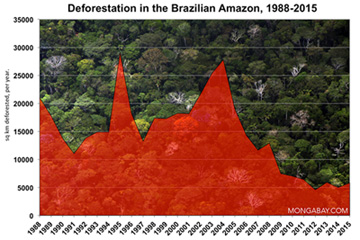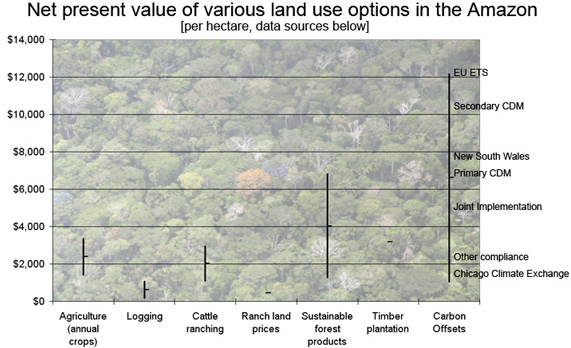Brazil’s ecosystem payments system offers clues for REDD implementation
Brazil’s ecosystem payments system offers clues for REDD implementation
mongabay.com
February 25, 2008
|
|
Brazil’s existing system for environmental services payments could offer insight for implementing carbon-credits-for-forest-conservation (REDD) initiatives in the Amazon rainforest, argues a London School of Economics researcher in a new paper published in Philosophical Transactions of the Royal Society B.
Reviewing the performance of Brazil’s Programme for the Socio-Environmental Development of Rural Family Production (Proambiente), Anthony Hall writes that “despite being fraught with problems, Proambiente is one tool among many which could reward small producers for enhancing carbon sequestration and biodiversity conservation.”
Proambiente was launched four years ago as a way to compensate rural Brazilians for environmental services afforded by forests, including: “reduction or avoidance of deforestation; carbon sequestration; recuperation of ecosystem hydrological functions; soil conservation; preservation of biodiversity; and reduction of forest fire risks.” Hall reports that of 4200 participating families, 1768 have received total payments averaging $325 per household to date — well below what had been promised to Proambiente participants. Hall said the program suffered from “the lack of a national legal framework, limited funding, reduced implementation capacity, poor cross sector collaboration and incompatibility with existing regional development policies.”

|
Still, says Hall, by offering farmers incentives that promote conservation rather than deforestation, Proambiente is an important departure from pervious government policies in the Amazon.
“Official subsidies for Amazon settlement have historically encouraged deforestation rather than conservation. Yet [payments for environmental services – (PES)] could help alter this perverse pattern,” he writes. “One such set of policies involves providing financial rewards to rural landowners and resource users who adopt environmentally friendly practices, ranging from outright conservation to sustainable development techniques. Financial compensation in the form of PES rendered would reward resource-users for their efforts to either preserve forests and other natural resources intact, and/or introduce production systems that generate economic surplus and sustain local populations without destroying the resource base upon which people’s livelihoods depend.”
Hall says that increased funding from REDD schemes could bolster and expand programs like Proambiente, while offering lessons for implementation.
“The World Bank, for example, has set up a US$300 million [Forest Carbon Partnership Facility] to pilot RED schemes. Such initiatives could benefit thousands of poor family farmers in Amazonia and, indeed, the tropics generally, who depend for their livelihoods on natural resources but who struggle to make ends meet,” he writes. “After just 4 years in operation and having achieved modest success, Proambiente has demonstrated pitfalls that threaten to frustrate the realization of this potential.”
“On balance, however, using PES to promote reduced emissions from deforestation could help avert the potentially fatal consequences of current development patterns in Amazonia upon both the environment and on people’s livelihoods. In spite of the many challenges which must be faced, therefore, it is far better to be RED than dead,” he concludes.

Carbon offsets versus other types of land use in the Amazon rain forest. Environmentalists and conservation scientists say REDD — a carbon offset mechanism approved during December climate talks in Bali — holds great promise for funding rainforest compensation while at the same time improving rural incomes and fighting climate change. |
Anthony Hall (2008). Better RED than dead: paying the people for environmental services in Amazonia. Phil. Trans. R. Soc. B, DOI: 10.1098/rstb.2007.0026
Related articles
Brazil seeks $1B/yr in donations to save the Amazon
(2/23/2008) Brazil will establish a donation-based fund to help finance conservation in the Amazon, according to Bloomberg. The announcement comes after deforestation rates spiked during the last five months of 2007.
Small Amazon farmers especially vulnerable to climate change
(2/19/2008) Communicating the impact of climate change to small farmers in the Amazon will be key in helping them adapt to higher temperatures, more frequent and intense drought, and greater incidence of forest fires forecast for the region, according to a paper published in Philosophical Transactions of the Royal Society B.
How much would it cost to end Amazon deforestation?
(01/28/2008) With Brazil last week announcing a significant jump in Amazon deforestation during the second half of 2007, the question emerges, how much would it cost to end the destruction of Earth’s largest rainforest? According to estimates by the Woods Hole Research Institute (WHRC), reducing deforestation in the Brazilian Amazon to nearly zero within a decade would cost $100 million to $600 million per year under a program involving carbon credits for forest conservation (REDD).
Amazon deforestation could be eliminated with carbon priced at $3
(12/4/2007) The Amazon rainforest could play a major part in reducing greenhouse gas emissions that result from deforestation, reports a new study published by scientists at the Woods Hole Research Center, the Instituto de Pesquisa Ambiental da Amazonia, and the Universidade Federal de Minas Gerais. At a carbon price of $3 per ton, protecting the Amazon for its carbon value could outweigh the opportunity costs of forgoing logging, cattle ranching, and soy expansion in the region. 2008 certified emission-reduction credits for carbon currently trade at more than $90 per ton ($25 per ton of CO2).
Could the carbon market save the Amazon rainforest?
(11/29/2007) The global carbon market could play a key role in saving the Amazon from the effects of climate change and economic development, which could otherwise trigger dramatic ecological changes, reports a new paper published in Science. The authors argue that a well-articulated plan, financed by carbon markets, could prevent the worst outcomes for the Amazon forest while generating economic benefits for the region’s inhabitants.
Dutch bank arranges carbon-conservation deal in the Amazon rainforest
(11/27/2007) Dutch bank Rabobank will launch the first-ever carbon credits project in the Xingu region of the Brazilian Amazon, reports The Financial Times.
Is the Amazon more valuable for carbon offsets than cattle or soy?
(10/17/2007) After a steep drop in deforestation rates since 2004, widespread fires in the Brazilian Amazon (September and October 2007) suggest that forest clearing may increase this year. All told, since 2000 Brazil has lost more than 60,000 square miles (150,000 square kilometers) of rainforest — an area larger than the state of Georgia or the country of Bangladesh. Most of this destruction has been driven by clearing for cattle pasture and agriculture, often in association with infrastructure development and improvements. Higher commodity prices, especially for beef and soy, have further spurred forest conversion in the region. While drivers of Amazon deforestation are stronger than ever, mounting concerns over climate change and the effort to reign in greenhouse gas emissions may provide new economic incentives for landowners to preserve forest lands through a concept known as “avoided deforestation”.
Do Costa Rica’s payments for environmental services work?
(09/17/2007) While Costa Rica is now known as a world leader for conversation policies and ecotourism, the Central American country had some of the world’s highest deforestation rates prior to establishing its reputation. Clearing for cattle pasture and agriculture destroyed much of the country’s biodiverse rainforests in the 1960s and 1970s.